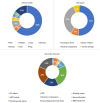Animal models for the study of intracranial hematomas (Review)
- PMID: 36561628
- PMCID: PMC9748783
- DOI: 10.3892/etm.2022.11719
Animal models for the study of intracranial hematomas (Review)
Abstract
Intracranial hematomas (ICH) are a frequent condition in neurosurgical and neurological practices, with several mechanisms of primary and secondary injury. Experimental research has been fundamental for the understanding of the pathophysiology implicated with ICH and the development of therapeutic interventions. To date, a variety of different animal approaches have been described that consider, for example, the ICH evolutive phase, molecular implications and hemodynamic changes. Therefore, choosing a test protocol should consider the scope of each particular study. The present review summarized investigational protocols in experimental research on the subject of ICH. With this subject, injection of autologous blood or bacterial collagenase, inflation of intracranial balloon and avulsion of cerebral vessels were the models identified. Rodents (mice) and swine were the most frequent species used. These different models allowed improvements on the understanding of intracranial hypertension establishment, neuroinflammation, immunology, brain hemodynamics and served to the development of therapeutic strategies.
Keywords: cerebral hemodynamics; experimental animal models; intracranial hematoma; intracranial hypertension; intracranial pressure.
Copyright: © Paiva et al.
Conflict of interest statement
The authors declare that they have no competing interests.
Figures





Similar articles
-
Experimental high-altitude intracerebral hemorrhage in minipigs: histology, behavior, and intracranial pressure in a double-injection model.Acta Neurochir (Wien). 2013 Apr;155(4):655-61. doi: 10.1007/s00701-013-1618-z. Epub 2013 Jan 17. Acta Neurochir (Wien). 2013. PMID: 23322012
-
Assessing the Evolution of Intracranial Hematomas by using Animal Models: A Review of the Progress and the Challenges.Metab Brain Dis. 2021 Dec;36(8):2205-2214. doi: 10.1007/s11011-021-00828-y. Epub 2021 Aug 21. Metab Brain Dis. 2021. PMID: 34417943 Review.
-
Modeling intracerebral hemorrhage in mice: injection of autologous blood or bacterial collagenase.J Vis Exp. 2012 Sep 22;(67):e4289. doi: 10.3791/4289. J Vis Exp. 2012. PMID: 23023153 Free PMC article.
-
Mouse models of intracerebral hemorrhage in ventricle, cortex, and hippocampus by injections of autologous blood or collagenase.PLoS One. 2014 May 15;9(5):e97423. doi: 10.1371/journal.pone.0097423. eCollection 2014. PLoS One. 2014. PMID: 24831292 Free PMC article.
-
Aspects of intracerebral hematomas--an update.Acta Neurol Scand. 2008 Dec;118(6):347-61. doi: 10.1111/j.1600-0404.2008.01023.x. Epub 2008 May 7. Acta Neurol Scand. 2008. PMID: 18462476 Review.
Cited by
-
Chemical Composition and Neuroprotective Properties of Indonesian Stingless Bee (Geniotrigona thoracica) Propolis Extract in an In-Vivo Model of Intracerebral Hemorrhage (ICH).Nutrients. 2024 Jun 14;16(12):1880. doi: 10.3390/nu16121880. Nutrients. 2024. PMID: 38931235 Free PMC article.
-
Neutrophil-like pH-responsive pro-efferocytic nanoparticles improve neurological recovery by promoting erythrophagocytosis after intracerebral hemorrhage.Theranostics. 2024 Jan 1;14(1):283-303. doi: 10.7150/thno.90370. eCollection 2024. Theranostics. 2024. PMID: 38164152 Free PMC article.
References
-
- Andrade AF, Paiva WS, Amorim RL, Figueiredo EG, Almeida AN, Brock RS, Bor-Seng-Shu E, Teixeira MJ. Continuous ventricular cerebrospinal fluid drainage with intracranial pressure monitoring for management of posttraumatic diffuse brain swelling. Arq Neuropsiquiatr. 2011;69:79–84. doi: 10.1590/s0004-282x2011000100016. - DOI - PubMed
-
- Paiva WS, de Andrade AF, de Amorim RL, Muniz RK, Paganelli PM, Bernardo LS, Figueiredo EG, Teixeira MJ. The prognosis of the traumatic subarachnoid hemorrhage: A prospective report of 121 patients. Int Surg. 2010;95:172–176. - PubMed
-
- van Asch CJ, Luitse MJ, Rinkel GJ, van der Tweel I, Algra A, Klijn CJ. Incidence, case fatality, and functional outcome of intracerebral haemorrhage over time, according to age, sex, and ethnic origin: A systematic review and meta-analysis. Lancet Neurol. 2010;9:167–176. doi: 10.1016/S1474-4422(09)70340-0. - DOI - PubMed
Publication types
LinkOut - more resources
Full Text Sources
